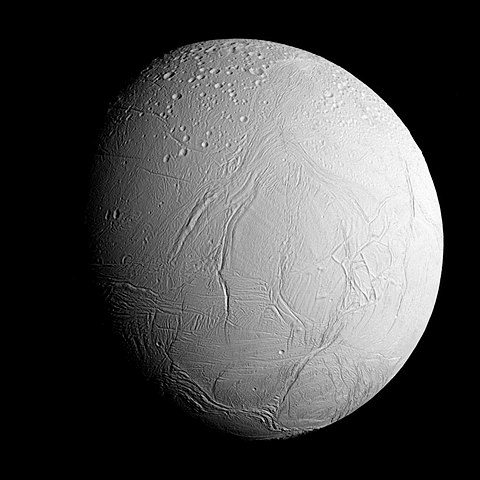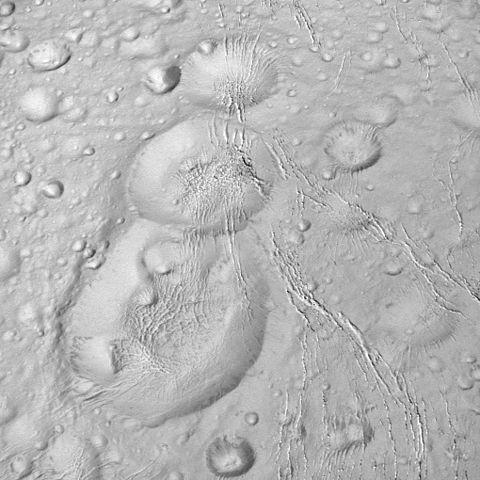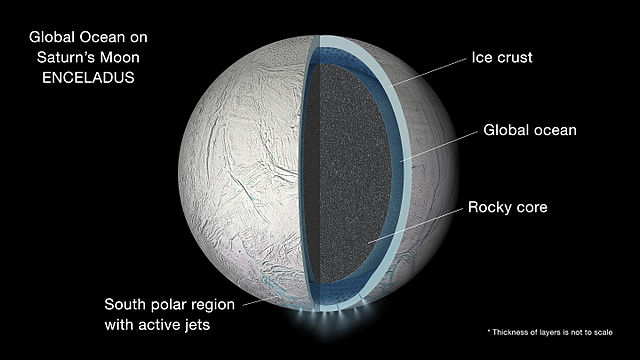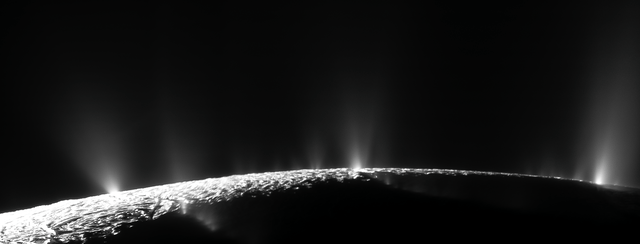Saturn’s moon, Enceladus, is a small icy world that has captivated astronomers and astrobiologists for many years. It is one of the most fascinating and mysterious moons in our solar system, and its exploration has yielded remarkable discoveries.
Despite being just 500 kilometers in diameter, it holds many secrets that could provide insight into the origins of life in our universe.
Introduction
Enceladus is located within the E Ring of Saturn and is the sixth largest moon of Saturn. It orbits at a distance of 238,000 kilometers from Saturn. Its surface is composed primarily of water ice and is heavily cratered, indicating it is much older than most of the other moons in the Solar System.
The most significant discovery about Enceladus is the presence of a subsurface ocean that is believed to have been created by tidal forces from Saturn. Recent observations have revealed that this ocean is likely to be salty and warm, a potential indicator of life in the universe.
The ocean is thought to have been formed in a process called tidal heating, in which the moon’s gravitational pull creates friction with Saturn, causing the moon to heat up from within.

First observed in 1789, Enceladus was initially thought to be a dead and lifeless moon. But, as we explore more and more of its features, we are discovering that it is an incredibly active and vibrant world, with its own unique geological and topographical features. Recent observations of the moon’s surface have revealed plumes of water vapor that are believed to originate from its subsurface ocean.
The Cassini mission to Saturn was the first mission to explore Enceladus in detail, and it has provided us with a wealth of information about the moon. The Cassini mission revealed evidence of ongoing geological activity on the moon’s surface, such as the presence of plumes and geysers.
Further observations from Cassini have revealed a global ocean beneath the moon’s icy crust and the presence of hydrothermal vents along the ocean floor.
The exploration of Enceladus has revealed many remarkable discoveries and has provided us with insight into the origins of life in the universe. In this article, we will explore the composition of Enceladus, its geological features, its exploration history, and the implications of its exploration.
We will discuss the reasons for exploring Enceladus, the composition of its surface, its internal activity, and its plume.
We will also look at the results of the Cassini mission, and the potential for future exploration of the moon. Finally, we will discuss the implications of our discoveries and the unanswered questions that remain.
Composition of Enceladus
Saturn’s moon Enceladus is one of the most interesting and mysterious celestial bodies. It is composed of a variety of different materials, resulting in a complex composition that has only recently been discovered thanks to advancements in technology.
The most prominent material found on Enceladus is its surface layer of water ice. This icy layer covers the moon in its entirety, with a few exceptions. The exact composition of this layer of ice has been the subject of many studies, and the results suggest that there is a mixture of ice types, including clayey ice, crystalline ice, and polygonal-type ice.
The moon also contains a rocky core composed of silicate rock, sulfur, and other material. This inner core is thought to be the result of a collision with another object in the early days of the Solar System, which caused the rocky material to become embedded in the ice.
Enceladus also has an atmosphere, which is composed mainly of nitrogen, water vapor, and carbon dioxide. This atmosphere gives the moon a bluish hue and can be seen clearly when looking at the night sky.
The different materials that make up Enceladus mean that it is a complex celestial body, with a variety of components that need to be studied in order to fully understand its composition. This makes it an interesting target for exploration, and one that we are only just beginning to understand.
Geology of Enceladus
Saturn’s moon Enceladus is a fascinating celestial body, and its geology has been long studied since its discovery in 1789. Its surface is composed of a thick crust of water ice, which gives it a smooth and bright appearance. Beneath the surface lie a rocky core, deep ocean oceans, and an atmosphere. To better understand the geology of Enceladus, and the amazing features it holds, further exploration of the moon is necessary.
Enceladus is believed to be geologically active, with ongoing tectonic activity leading to the creation and destruction of surface features. This is evidenced by the numerous craters, fissures, ridges, and other features seen on the moon’s surface. The activity is thought to be driven by the tidal forces of Saturn and other moons, causing a flexing on the surface.
The activity on the surface of Enceladus is thought to be an extension of internal activity, as well. This internal activity is driven by the gravitational pull from the other moons and Saturn, leading to friction and heat that is responsible for the melting of the planet’s icy surface and maintaining its liquid ocean beneath.

One of the most well-known features of Enceladus is its plume, which is made up of water vapor, ice particles, and other material that is ejected into space from the moon’s south pole. The plume is believed to be the result of hydrothermal activity deep within the ocean of the moon, and it is thought to be one of the primary sources of the moon’s internal heat.
The Cassini mission, launched in 1997, provided valuable information on the geology of Enceladus. It was during this mission that the plume was first discovered, and the mission also recorded evidence of geological activity on the surface. The mission also revealed the presence of a subsurface ocean, which is believed to be the source of the plume.
The results of the Cassini mission have led to a greater understanding of Enceladus and its geology, but there are still many unanswered questions. Future missions to the moon could help to further explore the geology of Enceladus and could provide insight into the internal structure and composition of the moon.
By studying the geology of Enceladus, scientists and researchers can gain a greater understanding of this mysterious, active moon.
Exploration of Enceladus
The exploration of Saturn’s moon Enceladus has been a major focus of astronomy and space exploration for the past two decades. In 2004, the Cassini mission was launched to explore Saturn and its moons. Cassini made numerous close flybys of Enceladus, taking detailed observations and gathering data about the geology and composition of the moon.
The data from Cassini provided insight into the geology of Enceladus and the composition of its surface. It showed that the moon is geologically active, with surface features indicating recent tectonic activity and a network of fractures and ridges possibly indicative of internal geological activity.
Cassini also observed an abundance of water ice on Enceladus’s surface, as well as evidence of a subsurface ocean.
The Cassini mission was also able to observe the “Enceladus Plume”, an active geyser of material emanating from the moon’s south pole. This plume was found to be composed of a mix of water, dust, and organic molecules, suggesting hydrothermal activity beneath the moon’s surface.
This was the first hard evidence of active hydrothermal activity on any of Saturn’s moons and raised the possibility of a form of life existing within Enceladus.

Further exploration was planned for the Cassini mission, but unfortunately, the mission was terminated shortly before its planned end date. The mission had achieved some remarkable results, but much was still left to explore. The water ice, rocky core, and atmosphere composition of Enceladus are still only partially understood, and the internal activity of the moon was only partially investigated.
Future missions are planned to continue the exploration of Enceladus and Saturn’s other moons. NASA is working on a mission to send a robotic spacecraft to Saturn and its moons, with the goal of continuing the exploration begun by Cassini.
The mission, dubbed the Europa Clipper, is planned to launch in the mid-2020s and will be able to make detailed observations of Enceladus and its geology, atmosphere, and internal activity.
The exploration of Enceladus has been an exciting endeavor for the past two decades, and the coming years promise to bring even more detailed insight into the geology and composition of Saturn’s icy moon.
The exploration of Enceladus has the potential to unlock many secrets about the universe around us, and its promise of discovery is highly anticipated by space enthusiasts.
Internal Activity
The internal activity of Saturn’s moon Enceladus has been a topic of much exploration and speculation. This activity is characterized by a variety of features, such as tectonic activity, surface features, and its surprisingly active internal structure.
Subsurface Ocean Composition
The preliminary findings of the Cassini mission of Saturn’s moon Enceladus have shown that Enceladus has a surprisingly active internal structure, with a large liquid ocean beneath its icy crust. In addition to its liquid ocean, Enceladus also has a rocky core with a diameter of about 150 km.
The high levels of heat and energy within the moon’s interior suggest that it has an active geologic and chemical history that may still be going on today.
Hydrothermal Activity
One of the most interesting findings of the Cassini mission was the discovery of hydrothermal activity on the ocean floor of Enceladus.
The presence of hydrothermal vents suggests that the moon has a dynamic interior and the potential for chemical reactions and other processes that could be conducive to the emergence of life.
Evidence of Life
The presence of hydrothermal activity on the floor of Enceladus’ ocean has led to speculation that the moon could potentially be a home for life. In particular, the presence of organic molecules in the samples taken by the Cassini spacecraft from the Enceladus plume suggests that the moon could be a potential host for primitive life forms.
The possibility of life on Enceladus has led to a number of recent missions aimed at exploring the interior of the moon and the composition of its interior ocean.
Researchers are hoping to gain greater insights into the potential habitability of Enceladus and its potential for hosting life.
These missions have begun to take advantage of the unique features of Enceladus, such as its close proximity to Saturn and its relatively low gravitational pull. In addition, the Cassini mission has also provided valuable data on the composition of the moon’s interior ocean and its potential for hosting life.
The exploration of Enceladus’ interior is an exciting and ongoing process. The potential for hosting life, combined with its unique geological features, has made it a prime target for exploration.
The recent missions have provided valuable insights into the moon’s interior and have shed light on its potential for hosting life.
The Enceladus Plume
Saturn’s moon Enceladus is the source of some of the most fascinating discoveries in the study of our solar system. Its icy and active surface is unique in the solar system and is believed to be powered by a vast internal ocean of liquid water.
At the south pole of Enceladus lies an icy plume of geyser-like eruptions, which was first discovered by the Cassini spacecraft.
This plume is composed of tiny ice and water vapor particles, a combination of ice and water that was not known to exist elsewhere in our solar system.
The formation of the Enceladus plume is believed to be the result of pressurized jets of water from its subsurface ocean. These jets break the icy crust of Enceladus, creating an icy spray that extends out thousands of kilometers into space.
The composition of the plume gives us insight into the composition of the internal ocean of Enceladus. The icy particles of the plume are made up of almost pure water ice, which suggests that the internal ocean is likely to be a mix of liquid water and ice.

Additionally, the plume also contains small amounts of methane, carbon dioxide, and other molecular species, which suggests that the ocean may contain organic molecules and minerals.
The distribution of the plume has also been studied extensively. Measurements of the Cassini spacecraft have revealed that the plume contains a variety of different particles, from large chunks of ice to microscopic droplets. It is believed that the plume is the result of a complex network of fractures in the surface of Enceladus.
Finally, the plume provides insight into the interior of Enceladus. Observations of the plume have revealed that the internal ocean is likely to be geologically active. The presence of methane and other organic molecules in the plume hints at the possibility of hydrothermal activity within the moon, which could be an important factor in the emergence of life.
The plume of Enceladus is one of the most remarkable features of the solar system, and has provided scientists with a unique window into the composition and geological activity of this mysterious moon.
The plume has shown us that the subsurface ocean of Enceladus is likely to be a rich and diverse environment, and may be an ideal location for further exploration in the search for life.
Facts
Enceladus is the sixth-largest moon of Saturn
Enceladus is the 19th largest in the Solar System
It is about 500 kilometers (310 miles) in diameter
Enceladus was discovered on August 28, 1789, by William Herschel
Enceladus is named after the giant Enceladus of Greek mythology
Enceladus’ rotation is ‘tidally locked’ to Saturn as it orbits
It orbits Saturn every 32.9 hours
A later study from 2019 estimated that the ocean is around one billion years old.
It orbits at 238,000 km from Saturn’s center and 180,000 km from its cloud tops
The icy particles from Enceladus spread out to space and feed the nearby E-ring with material.
Cassini performed chemical analysis of Enceladus’s plumes, finding evidence for hydrothermal activity
Voyager 2 was the first spacecraft to observe Enceladus’s surface in detail, in August 1981.
Enceladus reflects 100% of the light it receives, making it the most reflective object in the entire solar system.
Enceladus has an extremely thin atmosphere consisting mainly of water vapor.
surface temperatures on Enceladus are on average around -201C
The water ice erupting from the south pole of Enceladus is probably caused by an ocean under its frozen surface
Cassini detected huge amounts of organic chemicals emanating from the small moon.
Sodium has also been detected in the plumes
More than 100 geysers have been identified
Cassini found evidence for a large south polar subsurface ocean of liquid water with a thickness of around 10 km
Scientists believe that Enceladus has a rocky core
Scientists also believe it has a 30-40 km thick ice shell at the south polar region.
The two Voyager spacecraft made the first close-up images of Enceladus
Information
| Discovery | |||||||||||||
|---|---|---|---|---|---|---|---|---|---|---|---|---|---|
| Discovered by | William Herschel | ||||||||||||
| Discovery date | August 28, 1789 | ||||||||||||
| Designations | |||||||||||||
|
Designation
|
Saturn II | ||||||||||||
| Pronunciation | ɛnˈsɛlədəs | ||||||||||||
|
Named after
|
Egkelados | ||||||||||||
| Orbital characteristics | |||||||||||||
|
Semi-major axis
|
237948 km | ||||||||||||
| Eccentricity | 0.0047[ | ||||||||||||
|
Orbital period (sidereal)
|
1.370218 d | ||||||||||||
| Inclination | 0.009° (to Saturn’s equator) | ||||||||||||
| Satellite of | Saturn | ||||||||||||
| Physical characteristics | |||||||||||||
| Dimensions | 513.2 × 502.8 × 496.6 km | ||||||||||||
|
Mean radius
|
252.1±0.2 km (0.0395 Earths, 0.1451 Moons) | ||||||||||||
| Mass | (1.080318±0.00028)×1020 kg[8] (1.8×10−5 Earths) | ||||||||||||
|
Mean density
|
1.6097±0.0038 g/cm3 | ||||||||||||
|
Surface gravity
|
0.113 m/s2 (0.0116 g) | ||||||||||||
|
Moment of inertia factor
|
0.3305±0.0025 | ||||||||||||
|
Escape velocity
|
0.239 km/s (860.4 km/h) | ||||||||||||
|
Synodic rotation period
|
Synchronous | ||||||||||||
|
Axial tilt
|
0 | ||||||||||||
| Albedo | 1.375±0.008 (geometric at 550 nm) or 0.81±0.04 (Bond) | ||||||||||||
|
|||||||||||||
|
Apparent magnitude
|
11.7 | ||||||||||||
| Atmosphere | |||||||||||||
|
Surface pressure
|
Trace, significant spatial variability | ||||||||||||
| Composition by volume | 91% water vapor 4% nitrogen 3.2% carbon dioxide 1.7% methane |
||||||||||||
